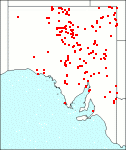Family: Frankeniaceae
Frankenia serpyllifolia
Citation:
Lindley in T.L Mitchell, J. Trop. Austral. 305 (1848).
Synonymy: F. serpyllifolia Lindley var. eremophila J. Black, Trans. R. Soc. S. Aust. 42:179 (1918); F. connata Sprague, Kew Bull. 1925:426 (1925); F. flabellata Sprague, Kew Bull. 1925:427 (1925); F. angustipetala Summerh., J. Linn. Soc.(Bot.) 48:374 (1930); F. densa Summerh., J. Linn. Soc.(Bot.) 48:373 (1930); F. eremophila (J. Black)Summerh., J. Linn. Soc.(Bot.) 48:375 (1930); F. gracilis Summerh., J. Lin. Soc.(Bot.) 48:380 (1930); F. hamata Summerh., J. Linn. Soc.(Bot.) 48:381 (1930); F. latior Sprague & Summerh., J. Linn. Soc.(Bot.) 48:376 (1930); F. planifolia Sprague & Summerh., J. Linn. Soc.(Bot.) 48:377 (1930); F. uncinata Sprague & Summerh., J. Linn. Soc.(Bot.) 48:381 (1930).
, Frankenia pauciflora Common name: Bristly (or clustered or dainty or downy or hairy) sea-heath.
Description:
Low densely branched sprawling to erect shrubs, sometimes rooting at the nodes; branches differentiated into long- and short-shoots, sparsely to densely pilose, occasionally glabrous, hairs spreading to uncinate, 0.05-1.2 mm long, internodes 5-32 mm long; long-shoot leaves 3-13 mm long; leaf bases usually tapering toward the distal end, medially somewhat thickened, flattened toward the margins, 0.4-2.7 mm long, 0.3-0.8, rarely up to 1.2 mm wide at the distal end; leaf blades oblong, elliptic, ovate, oblanceolate or obovate to linear or narrowly elliptic, 1-7.5 mm wide, flat or with margins loosely to tightly revolute; mid-vein inconspicuous to broad, flat and very prominent, linear to broadened somewhat at the base; surfaces a greyish yellow-green, adaxial and abaxial surfaces glabrous to densely puberulent or pilose, hairs spreading to uncinate and 0.05-0.9 mm long; short-shoot leaves similar to long-shoot leaves.
Flowers borne at the top 1-19 nodes of the upper branches in terminal or axillary dichasia with 2-70 flowers or solitary in axils; floral bracts leaf-like, usually somewhat shorter than the leaves, connate at the base into whorls of 4; calyces 5-lobed, 4-10 mm long, 0.9-2 mm wide, tubular to somewhat dilated toward the apex, glabrous to densely puberulent or pilose, hairs spreading to uncinate and 0.03-0.8 mm long; petals usually 5, rarely 4, spathulate to occasionally narrowly oblong-oblanceolate, 6-15.2 mm long; stamens 6, in 2 unequal whorls, 4.2-12.2 mm long; styles 4-9.8 mm long; style-branches 2 or 3, rarely 4, 1-5 mm long; stigmas terminal, oblique, terete to lightly swollen at the tips, 0.4-1.5 rarely 0.3 mm long; ovaries with 2 or 3 short basal-parietal placentae; ovules typically 2 or 3, 1 or occasionally 2 per placenta, attached 0.06-0.3 rarely up to 0.5 mm from the carpel base, pendulous on long recurving funicles.
Published illustration:
Erickson et al. (1973) Flowers and plants of Western Australia, p. 143; Williams (1979) Native plants of Queensland 1:127; Cunningham et al. (1982) Plants of western New South Wales, pp. 500 & 501.
|
|
Distribution:
|
S.Aust.: NW, LE, NU, GT, FR, EA, EP, NL, MU. N.T.; QLD; N.S.W.; Vic.
|
Conservation status:
native
Flowering time: Jan. — Dec.
|

SA Distribution Map based
on current data relating to
specimens held in the
State Herbarium of South Australia
|
Biology:
No text
Taxonomic notes:
Frankenia serpyllifolia is a highly variable species which shows a weak level of geographical differentiation over its range. For example, plants along the Nullarbor Plain tend to have unusually broad prominent mid-veins. Pubescence, in particular, is highly variable and there is a tendency for the frequency of plants with uncinate hairs to increase from southern to northern S.Aust. However, variation in these characters is very gradual, and there is considerable interpopulational variation within, as well as between, regions. Numerous species all considered synonymous with F. serpyllifolia here, have previously been described on the basis of leaf shape and size; pubescence type, length and abundance; and mid-vein prominence. However, there is so much overlap in the characters which distinguish these species, that they are considered insufficiently distinct to warrant recognition here.
Author:
Not yet available
|

